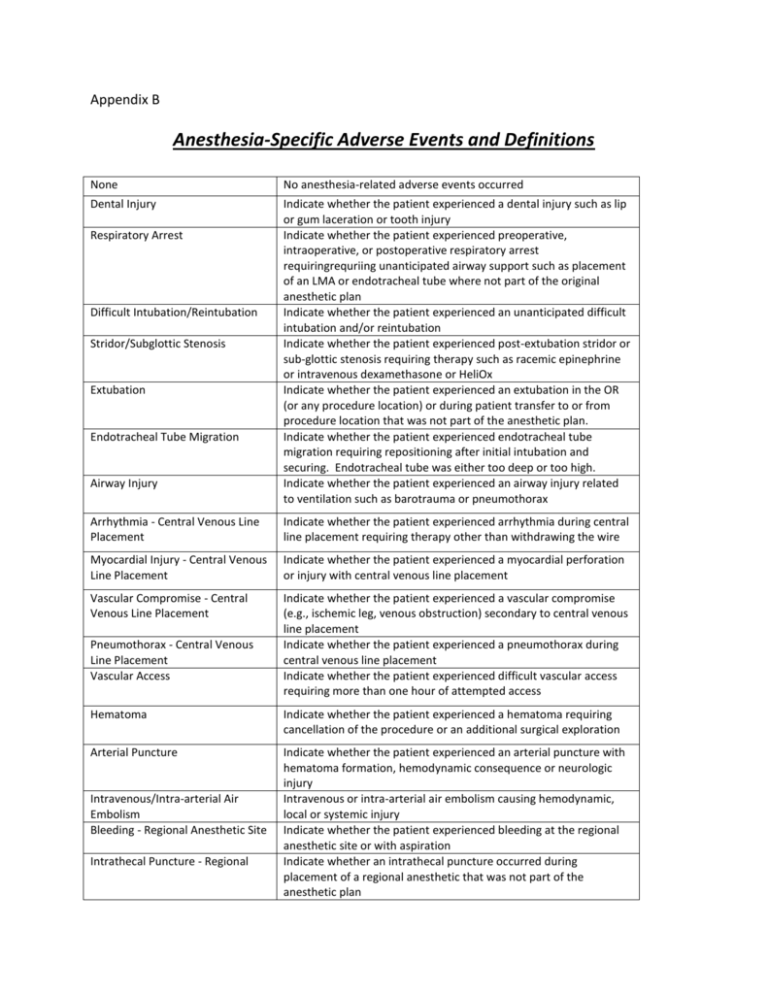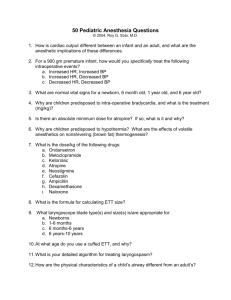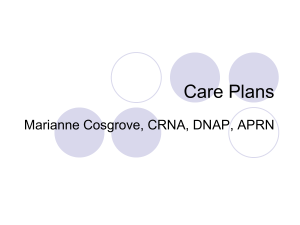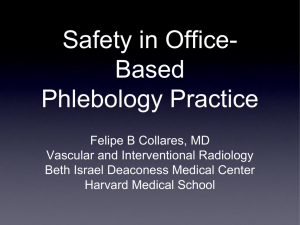Appendix B
advertisement

Appendix B Anesthesia-Specific Adverse Events and Definitions None No anesthesia-related adverse events occurred Dental Injury Indicate whether the patient experienced a dental injury such as lip or gum laceration or tooth injury Indicate whether the patient experienced preoperative, intraoperative, or postoperative respiratory arrest requiringrequriing unanticipated airway support such as placement of an LMA or endotracheal tube where not part of the original anesthetic plan Indicate whether the patient experienced an unanticipated difficult intubation and/or reintubation Indicate whether the patient experienced post-extubation stridor or sub-glottic stenosis requiring therapy such as racemic epinephrine or intravenous dexamethasone or HeliOx Indicate whether the patient experienced an extubation in the OR (or any procedure location) or during patient transfer to or from procedure location that was not part of the anesthetic plan. Indicate whether the patient experienced endotracheal tube migration requiring repositioning after initial intubation and securing. Endotracheal tube was either too deep or too high. Indicate whether the patient experienced an airway injury related to ventilation such as barotrauma or pneumothorax Respiratory Arrest Difficult Intubation/Reintubation Stridor/Subglottic Stenosis Extubation Endotracheal Tube Migration Airway Injury Arrhythmia - Central Venous Line Placement Indicate whether the patient experienced arrhythmia during central line placement requiring therapy other than withdrawing the wire Myocardial Injury - Central Venous Line Placement Indicate whether the patient experienced a myocardial perforation or injury with central venous line placement Vascular Compromise - Central Venous Line Placement Indicate whether the patient experienced a vascular compromise (e.g., ischemic leg, venous obstruction) secondary to central venous line placement Indicate whether the patient experienced a pneumothorax during central venous line placement Indicate whether the patient experienced difficult vascular access requiring more than one hour of attempted access Pneumothorax - Central Venous Line Placement Vascular Access Hematoma Indicate whether the patient experienced a hematoma requiring cancellation of the procedure or an additional surgical exploration Arterial Puncture Indicate whether the patient experienced an arterial puncture with hematoma formation, hemodynamic consequence or neurologic injury Intravenous or intra-arterial air embolism causing hemodynamic, local or systemic injury Indicate whether the patient experienced bleeding at the regional anesthetic site or with aspiration Indicate whether an intrathecal puncture occurred during placement of a regional anesthetic that was not part of the anesthetic plan Intravenous/Intra-arterial Air Embolism Bleeding - Regional Anesthetic Site Intrathecal Puncture - Regional Local Anesthetic Toxicity – Regional Indicate whether the patient experienced local anesthetic toxicity during administration of regional anesthesia Neurologic Injury - Regional Indicate if a neurologic injury occurred potentially associated with a regional anesthetic Indicate whether the patient experienced an anaphylaxis/anaphylactoid reaction (hives, wheezing, cardiovascular changes) Indicate whether the patient experienced a non-allergic drug reaction (e.g., "Red Man" syndrome with vancomycin) Anaphylaxis/Anaphylactoid Reaction Non-allergic Drug Reaction Medication Administration Indicate if a medication was administered that was not part of the anesthetic plan at the time of administration Medication Dosage Indicate if a medication that was part of the anesthetic plan was given at a dosage or time different than planned Intraoperative Recall Indicate whether the patient experienced any intraoperative recall Malignant Hyperthermia Indicate whether the patient experienced either a suspected or confirmed episode of Malignant Hyperthermia requiring therapy with dantrolene. Indicate whether the patient experienced a significant protamine reaction requiring additional intervention (e.g., hypotension, bronchospasm, elevated pulmonary artery pressure) other than slowing the rate of administration Indicate whether the patient experienced cardiac arrest not related to the procedure Indicate whether the patient experienced esophageal bleeding or rupture during transesophageal echocardiogram (TEE) placement or manipulation Indicate whether the patient experienced esophageal chemical burn related to transesophageal echocardiogram (TEE) probe. Protamine Reaction Cardiac Arrest - Unrelated to Surgery Esophageal Bleeding / Rupture Esophageal Chemical Burn Airway Compromise TEE-Related Extubation Patient Transfer Event Neurologic Injury Indicate whether the patient experienced an airway compromise during transesophageal echocardiogram (TEE) placement / manipulation requiring removal of TEE. Indicate if the endotracheal tube was removed from the trachea during TEE manipulation Indicate whether the patient experienced any trauma related to transfers from stretcher to bed or bed to stretcher or similar transfers. Indicate whether the patient experienced a neurologic injury as a result of patient positioning during anesthetic care.







